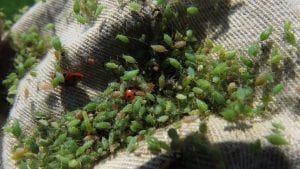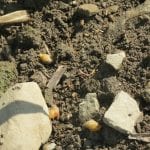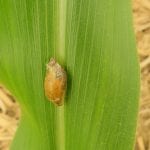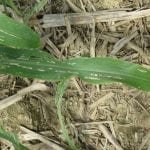Contents
Farmer Tick Survey, 2018 – From the NYSIPM Program
The Community IPM Program (part of NYSIPM) was funded by the NY State Senate Task Force on Lyme and Tick Borne Disease to create an educational campaign about the risks of tick exposure and tick awareness for New York. Community IPM addresses non-agricultural pest issues for every New York resident, including farmers. This survey is a research project to help us understand what tick issues and concerns NY farmers are facing on their farms and home properties. By completing this survey, you are agreeing to participate in this research. Your answers are completely anonymous and will help us understand how serious the issue is and how to raise awareness with the farming community.
For more information about this survey or about ticks and tick prevention or control, please contact Jody Gangloff-Kaufmann at jlg23@cornell.edu .
Please fill out the survey (just 10 questions!) here:
View from the Field
Kevin Ganoe (CCE Dairy and Field Crops Team Central NY) and Jeff Miller (CCE Oneida and Madison Counties) report high pea-aphid infestation populations. Pea aphids generally do not need to be sprayed for controlled because natural enemies like predators and parasitoids. Sometimes when you have high populations of pea aphid, you also have potato leafhopper populations over threshold. When you spray for potato leafhopper that is over threshold it will also control the pea aphids in the field.
Ken Wise (NYS IPM) observed a fair amount of snail/slug damage in corn and soybeans this week. It was not causing economic losses but the lower leaves of the corn and some leaflets on soybeans were showing symptoms. There was a lot of deer damage in soybeans.
Field Day Events
2018 CORNELL SEED GROWERS FIELD DAY
http://events.cornell.edu/event/2018_cornell_seed_growers_field_day
Tuesday, July 3, 2018 at 8:30am to 12:00pm
NYSIP Foundation Seed Barn
For seed growers, seed treatment applicators, and other seed professionals
Place: NYSIP Foundation Seed Barn, 791 Dryden Rd., Rt. 366, Ithaca, NY
Time: 8:30 AM – 12:00 noon
Cornell University Willsboro Research Farm Open House: Willsboro, NY – July 10, 2018
The Cornell University Willsboro Research Farm will hold an open house on Tuesday, July 10 from 1:30pm to 4:00pm. A tour of the facilities and research plots will leave the main office (48 Sayward Lane, Willsboro) at 2:00pm. Light refreshments will be provided. Research topics featured at this year’s open house include corn silage variety trials, adaptive nitrogen management for field corn, cover crops, juneberry nursery and production trials, Aronia variety plantings, honeyberry variety trial, high tunnel vegetable production, reduced tillage demonstration plots, season extension for early spring vegetables, organic pepper variety trial, and goldenberry and groundcherry variety evaluations. For more information call 518-963-7492.
2018 Aurora Farm Field Day: Thursday, July 12, 2018 at 9:30am to 3:30pm
Our annual Field Crops field day held at Musgrave Research Farm in Aurora, NY is set for July 12th. The field day is free and open to the public and includes a BBQ lunch.
Skip the registration line by PRE-REGISTERING!
DEC and CCA credits will be available. (DEC: Demonstration – 3.25, Agricultural Plant – 3.25, Field and Forage – 3.25, Vegetable – 1.25)
http://events.cornell.edu/event/2018_aurora_farm_field_day
Weather Outlook – June 28, 2018
Jessica Spaccio
NOAA Northeast Regional Climate Center, Cornell University
Weather Outlook –June 28, 2018
NOAA Northeast Regional Climate Center, Cornell University
Last week temperatures ranged from 8 degrees below normal to near- normal. Precipitation has ranged from less than ¼ “ to 2”. Base 50 growing degree-days ranged from 50-130. Abnormally dry conditions have been expanded for part of central NY.
HOT and humid over the weekend.
Today rain showers and isolated thunderstorms will continue as a system moves across the state; heavy rainfall possible for the Hudson Valley Region. Showers will diminish from west to east with temperatures in the 70s to low 80s and muggy. Overnight lows will be in the mid 50s to mid 60s.
Friday will be mostly sunny and warmer with highs in the 80s to near 90, but with lower humidity. Overnight temperatures will be in the upper 50s to mid 60s.
Saturday temperatures will be in the mid 80s to mid 90s, with sunny, hot, and humid conditions. Heat indices could reach the 100s. Overnight temperatures will be in the 60s to mid 70s.
Sunday highs will be in the upper 80s and 90s, as hot & humid conditions continue. Heat indices could reach the 100s. Overnight temperatures will be in the 60s to mid 70s.
Monday temperatures will be in the 80s to mid 90s with humid conditions and a chance for scattered showers and thunderstorms. Heat indices could reach the 100s. Overnight temperatures will be in the 60s to low 70s.
Tuesday will be partly to mostly cloudy with highs will be in the upper 70s to low 90s, with humid conditions and showers and thunderstorms possible. Overnight temperatures will be in the 60s.
Wednesday will be partly to mostly cloudy with highs will be in the upper 70s to low 90s, with humid conditions and showers and thunderstorms possible. Overnight temperatures will be in the 60s.
The seven-day precipitation amounts will range from a trace to one inch.
The 8-14 day outlook (July 5-11) favors above-normal temperatures for all of the state. The precipitation outlook favors near-normal amounts.
National Weather Service watch/warnings map
Storing grain? Not too early to think about protection from post-harvest insect pests
Keith Waldron, NYS IPM
Planning to store wheat on the farm? Are your grain bins ready? Wheat harvest is still a while off but it is not too early to begin thinking about gearing up for the big event. To maintain the profits a good yield can bring, make and follow a plan to protect your grain while it is in storage. Remember: Grain storage will not improve grain quality. However, proper management of grain during storage will protect the quality present at harvest.
The IPM approach for stored grain protection includes a combination of sanitation, well-sealed bins, frequent monitoring for temperature and insect populations, aeration to cool grain in the fall, and pest management treatments as needed. Stored grain management begins with “an ounce of prevention”. This article will highlight some steps one can take now to protect stored grain before it is harvested. The following pre-harvest information was “gleaned” whole or in part from Stored Grain IPM information from Oklahoma State University Stored Products Research & Education Center and Purdue University. Website source URL’s are provided at end of this article.
Insect infestations are the more common stored grain pest issues one might encounter. Insect infested grain can be docked at time of sale. Most common grain bin insect problems can be traced back to infestations in previously stored material, cracked grain and grain fines and trash. Don’t add new grain into storage bins that have not been cleaned and may harbor a collection of stored grain pests. The key to prevention is SANITATION – clean out the bin every time it is emptied. How clean? If you can tell what was stored in the bin the last time it was used, it needs more cleaning. In addition to insects, birds and rodents are also attracted to left over and spilled grain. Lights mounted on or in close proximity to grain bins may attract unwanted stored grain insects.
Who might the likely insect pests be? A variety of beetles, weevils and moths are common to stored grain infestations. Saw-toothed grain beetles, flat grain beetle, red flour beetles, granary weevils, Indian meal moths and Angoumois grain moths to name a few. A picture is worth a thousand words and the following extension factsheets provide information to help identify the insects you may find as you clean out your storage bins: Principal Stored Grain Insect Pests of Indiana, Stored Wheat Insects identification key (http://bru.gmprc.ksu.edu/proj/sga/key.asp) and Stored grain pests identification (http://storedgrain.com.au/wp-content/uploads/2013/05/Stored-grain-pests_NorthSouthWest_Pocketguide.pdf).
To prepare for grain harvest and storage the following sanitation practices are recommended.
* Clean harvest and transportation machines before harvest.
* Repair all grain handling equipment before harvest and keep it in good condition.
* Seal unloading auger, auger tube opening, and side door openings before harvest
* Empty storage structures of old grain. The new crop should never be stored on top of old grain.
* Remove and destroy any grain from beneath, around or near the bin area. Sweep and vacuum the floors, false floors, and walls inside empty bins to remove old grain and debris. This debris usually contains insect eggs, larvae, pupae, and/or adults, all ready to infest the new grain. A shop vacuum, broom and scoop are very useful in a cleanup job, and all collected material should be discarded properly.
* Check fan boxes for possible grain pests.
* Remove any spilled grain outside the storage structure.
* Mow / remove weeds at least 10 feet around the bins.
* Check and clean or replace rodent traps / bait stations. Be sure to follow all label directions.
* Check the integrity of screens and porcupine wires to limit bird entry and roosting.
* Insecticides? For additional protection against infestation, the inside and outside surfaces, foundations and floor of a storage facility can be sprayed with residual insecticide, four to six weeks prior to harvest, to kill any insects that were not removed during cleaning and those that migrate into the bin. Use appropriately registered insecticides. Be sure to follow all label directions. Rotate choice of insecticide chemical families to minimize risk of developing insecticide resistance.
* Establish a written sanitation schedule. Keep appropriate records.
Bin Sealing
Roof leaks commonly lead to columns of spoiled grain. Check for these leaks by looking for light coming into the bin. Moisture coming into the bin through the seal between the bin and concrete will cause spoilage around the perimeter of the bin at the base. Check the seal since sealants do deteriorate. Water will run away from the seal at the base of the bin wall if the concrete is sloped away from the bin. Also check the seals around the doors and hatches.
Besides keeping grain dry, grain storages should be well sealed for two other basic reasons: (1) to minimize grain insect entry problems into base and sidewall grain, and
(2) to minimize leakage should fumigants be used.
In addition, improved insect kill (efficacy), tighter sealed structures require lower dosage rates, which reduce the cost of future fumigations and cover the cost for the sealing materials and labor. When clean grain is transferred into a clean, sanitized structure with base and sidewalls well sealed, the main insect infestation and population growth should be on the grain surface in the structure headspace. Permanently sealing all non-functional base, sidewall and roof openings is the first priority of sealing storages. The second sealing priority is to seal functional openings at all times during the year when the component is not being used.
Source of the above stored grain pest management information:
Purdue’s Stored Product Pest factsheets:
Two excellent Stored Grain IPM resources:
“Stored Product Protection” – Practical guide to protecting grains and other raw commodities, food processing facilities, finished food, and durable plant and animal products from insects, molds, and vertebrate pests. Illustrated, 350 p. (http://www.ksre.ksu.edu/bookstore/pubs/S156.pdf)
“Maintaining Quality in On-Farm Stored Grain” https://utextension.tennessee.edu/publications/documents/PB1724.pdf
Degree Day for Field Crops across New York
New York Field Crop Pest Degree Day Accumulations for selected locations
(July 2, 2018)
| Station Location |
GDDs (Base 50 F) March 1 |
| Ceres | 903 |
| Chazy | 777 |
| Geneva | 976 |
| Highland | 1117 |
| Ithaca | 940 |
| Madrid | 906 |
| Massena | 827 |
| Northport (Richters) | 11054 |
| Valatie | 965 |
| Versailles | 990 |
| Watertown | 763 |
Clipboard Checklist
Keith Waldron, NYS IPM
General
*Walk fields to check general field condition, weed issues
*Watch for crop maturity, stand assessments, weed escapes, nutrient deficiencies, lodging issues
Alfalfa:
*Evaluate established legume stands for approximate days until harvest
*Monitor potato leafhopper, foliar, systemic and crown rot diseases.
*Monitor new seedings for potato leafhopper, pythium blight, phytopthora root rot.
Small Grains:
*Monitor small grains for signs of Fusarium Head Blight, foliar diseases
*Monitor grain fields for growth stage, disease issues, grain maturity, harvest timing
*Record diseases present, location and types of weed escapes
Corn:
*Monitor for mid-season corn pests including European corn borer, corn rootworm, western bean cutworm, slugs, foliar diseases such as northern corn leaf blight and gray leaf spot, weed issues, nutrient deficiencies, vertebrate damage.
Soybeans:
*Monitor for crop growth stage, soybean aphid, defoliators, foliar diseases, white mold, weed issues, vertebrate damage
Pastures:
*Check water sources, mend fences as needed.
*Check crop growth, clip pastures between grazing as needed
*Monitor for invasive species, plants harmful to livestock
*Review/Plan rotations
Equipment:
*Carry appropriate / necessary NYS DEC and EPA documents as needed: (pesticide applicators license, pesticide labels, MSDS sheets, etc.)
Storage:
* Check stored grain bins for temperature, moisture and signs of mold and insects. Aerate, core, transfer grain or treat as necessary
* Clean and disinfect empty storage bins in preparation for grain harvest
*Check forage allocation and anticipate feed program adjustments as forages from previous year are used up
*Mow around storage bins and facility to minimize pest hiding places
Dairy Cattle Barn Fly Management:
*Monitor animals and barn area for house fly, stable fly and other pest management needs including presence of rodents and birds.
*Check facilities for favorable fly breeding conditions: (organic matter + moisture): leaks in watering systems, roof gutters for leaks and potential overspill, drainage,
*Sanitation, sanitation, sanitation – clean animal resting areas, feed troughs, minimize source of moist organic matter i.e. fly breeding areas in barn and in adjacent animal loafing yard
* Continue fly monitoring: install “3X5″ index card fly speck monitoring cards throughout barn
*Use, replenish, replace fly management materials: sticky fly tapes/ribbons, insecticide baits, natural enemies (parasitoids), fly population monitoring (3 x 5) spot cards
*Consider purchase and release of Muscidifurax raptor and/or M. raptorellus natural enemies of house and stable fly pupae.
Dairy Cattle on Pasture:
*Monitor animals for presence of face flies, horn flies and stable flies. Action guidelines: face flies (average 10 per animal face), horn flies (average 50 / dairy per animal side, 200 / beef cattle per animal side), stable flies average 10 per animal (all four legs)
*Check feed bunk / water source locations for signs of stable fly breeding (moist undisturbed organic matter – spilled feed, round bales, etc.), minimize source of moist organic matter i.e. fly breeding areas in barn and in adjacent animal exercise yard.
*Check pasture for forage quality / quantity, rotate as appropriate
*Check pasture for vegetation poisonous to livestock
*Consider use of pasture fly traps to help reduce deer, horse and stable fly populations






